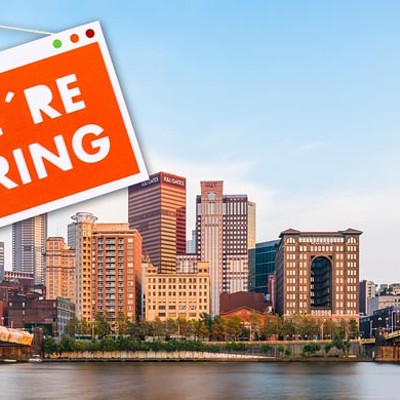The "Hot Metal Bridge" -- is it really hot? And where is it located?
Question submitted by: Jean Marcott, Follansbee, WV
The Hot Metal Bridge is easy to find. Just jump in the Monongahela River at the Point, swim three miles upstream -- try not to swallow any water on the way -- and look straight up. Less physically fit readers may prefer to simply drive along East Carson Street and turn left at South 29th Street, which will put you right on the bridge. (While there, you might want to scan the river below for floundering swimmers.)
Either way, you'll notice not one but two bridge spans, both sharing the same stone piers. Only the larger of the two, on the upstream side, is drivable; the other remains disused and has actually had most of its deck torn away. (Tip: Don't try to cross on that one.)
Pittsburghers tend to refer to both spans collectively as the "Hot Metal Bridge," but in fact only the narrower of the two deserves the name. Built by the Jones & Laughlin Steel Corporation around 1903, its function was to carry molten iron -- and yes, that would be the "hot metal" in question -- from the Eliza blast furnaces on the river's north bank to its steel furnaces and mills on the south shore.
The molten iron was shipped in low-slung insulated "torpedo cars" and ferried across the river by locomotive. Once it reached the South Side, the iron was poured into open-hearth furnaces and heated again to make steel. There, the steel was made and poured into ingots, some of which would be shipped back across the river -- this time on the wider bridge, known as the main bridge -- where it would again have to be reheated before it could be rolled into finished products. (If you've ever wondered how the Japanese kicked our asses back in the 1980s, there's a big clue right there.)
Why did J&L use such an inefficient system? Partly because its South Side Works were consolidated from a handful of independently-owned steel mills and suppliers. Founded by Benjamin Franklin Jones in the 1850s, the company acquired numerous firms along the riverbanks; in later years, the company struck while the iron was hot -- building finishing mills on the north side of the river because it had the room.
The Jones & Laughlin steel works shut down in 1987, and for the most part, use of the Hot Metal Bridge cooled at about the same time the plant did. But portions of the bridge did remain hot: LTV allowed utility companies to rent space on the underside of the span, and it was once knotted with steam lines, electrical cables and so on.
That's all changed since the city converted the main bridge to vehicle use. Formerly, writes Walter Kidney in Pittsburgh's Bridges: Architecture and Engineering, it "served the general purposes of the Monongahela Connecting Railroad." Now it serves the general purpose of connecting Oakland frat boys to Carson Street bars.
Incidentally, US Steel's Homestead Works had a Hot Metal Bridge of its own. It connected the Carrie Furnaces in Rankin to the plant's furnaces and mills on the river's south shore. This bridge may be converted to pedestrian use; if the site succeeds in its bid to become a national historic site, it will link the remaining Carrie furnaces to an interpretive historic museum.
Similar plans await the South Side span, although they've been on the back burner for a few years. The plan is to open the bridge for pedestrians, linking the biking and walking trails on opposite sides of the river. That, obviously, will require building ramps to connect the bridge to the ground & although frankly, I wouldn't mind if they opened the bridge now without completing the other side: It'd be a quick way to get rid of those obnoxious in-line skaters.
The bridge is still hot in another sense, however: It's become very popular with South Siders. By allowing easy access to the Parkway East, the main bridge has provided a useful link for us denizens of the flats -- now it's much easier to flee the neighborhood during this week's South Side Summer Street Spectacular. I'm fond of referring to it as "The Only Thing Mayor Murphy has Done For Me Memorial Span." Bit the good times may not last forever. Should the long-contested Mon-Fayette Expressway be built, its Pittsburgh off-ramp will deposit traffic less than a half-mile from the bridge. Perhaps someday soon, the bridge will again be laden with overheated lumps of metal. Only this time they'll be car engines, and they won't be headed anywhere at all.
Either way, you'll notice not one but two bridge spans, both sharing the same stone piers. Only the larger of the two, on the upstream side, is drivable; the other remains disused and has actually had most of its deck torn away. (Tip: Don't try to cross on that one.)
Pittsburghers tend to refer to both spans collectively as the "Hot Metal Bridge," but in fact only the narrower of the two deserves the name. Built by the Jones & Laughlin Steel Corporation around 1903, its function was to carry molten iron -- and yes, that would be the "hot metal" in question -- from the Eliza blast furnaces on the river's north bank to its steel furnaces and mills on the south shore.
The molten iron was shipped in low-slung insulated "torpedo cars" and ferried across the river by locomotive. Once it reached the South Side, the iron was poured into open-hearth furnaces and heated again to make steel. There, the steel was made and poured into ingots, some of which would be shipped back across the river -- this time on the wider bridge, known as the main bridge -- where it would again have to be reheated before it could be rolled into finished products. (If you've ever wondered how the Japanese kicked our asses back in the 1980s, there's a big clue right there.)
Why did J&L use such an inefficient system? Partly because its South Side Works were consolidated from a handful of independently-owned steel mills and suppliers. Founded by Benjamin Franklin Jones in the 1850s, the company acquired numerous firms along the riverbanks; in later years, the company struck while the iron was hot -- building finishing mills on the north side of the river because it had the room.
The Jones & Laughlin steel works shut down in 1987, and for the most part, use of the Hot Metal Bridge cooled at about the same time the plant did. But portions of the bridge did remain hot: LTV allowed utility companies to rent space on the underside of the span, and it was once knotted with steam lines, electrical cables and so on.
That's all changed since the city converted the main bridge to vehicle use. Formerly, writes Walter Kidney in Pittsburgh's Bridges: Architecture and Engineering, it "served the general purposes of the Monongahela Connecting Railroad." Now it serves the general purpose of connecting Oakland frat boys to Carson Street bars.
Incidentally, US Steel's Homestead Works had a Hot Metal Bridge of its own. It connected the Carrie Furnaces in Rankin to the plant's furnaces and mills on the river's south shore. This bridge may be converted to pedestrian use; if the site succeeds in its bid to become a national historic site, it will link the remaining Carrie furnaces to an interpretive historic museum.
Similar plans await the South Side span, although they've been on the back burner for a few years. The plan is to open the bridge for pedestrians, linking the biking and walking trails on opposite sides of the river. That, obviously, will require building ramps to connect the bridge to the ground & although frankly, I wouldn't mind if they opened the bridge now without completing the other side: It'd be a quick way to get rid of those obnoxious in-line skaters.
The bridge is still hot in another sense, however: It's become very popular with South Siders. By allowing easy access to the Parkway East, the main bridge has provided a useful link for us denizens of the flats -- now it's much easier to flee the neighborhood during this week's South Side Summer Street Spectacular. I'm fond of referring to it as "The Only Thing Mayor Murphy has Done For Me Memorial Span." Bit the good times may not last forever. Should the long-contested Mon-Fayette Expressway be built, its Pittsburgh off-ramp will deposit traffic less than a half-mile from the bridge. Perhaps someday soon, the bridge will again be laden with overheated lumps of metal. Only this time they'll be car engines, and they won't be headed anywhere at all.










